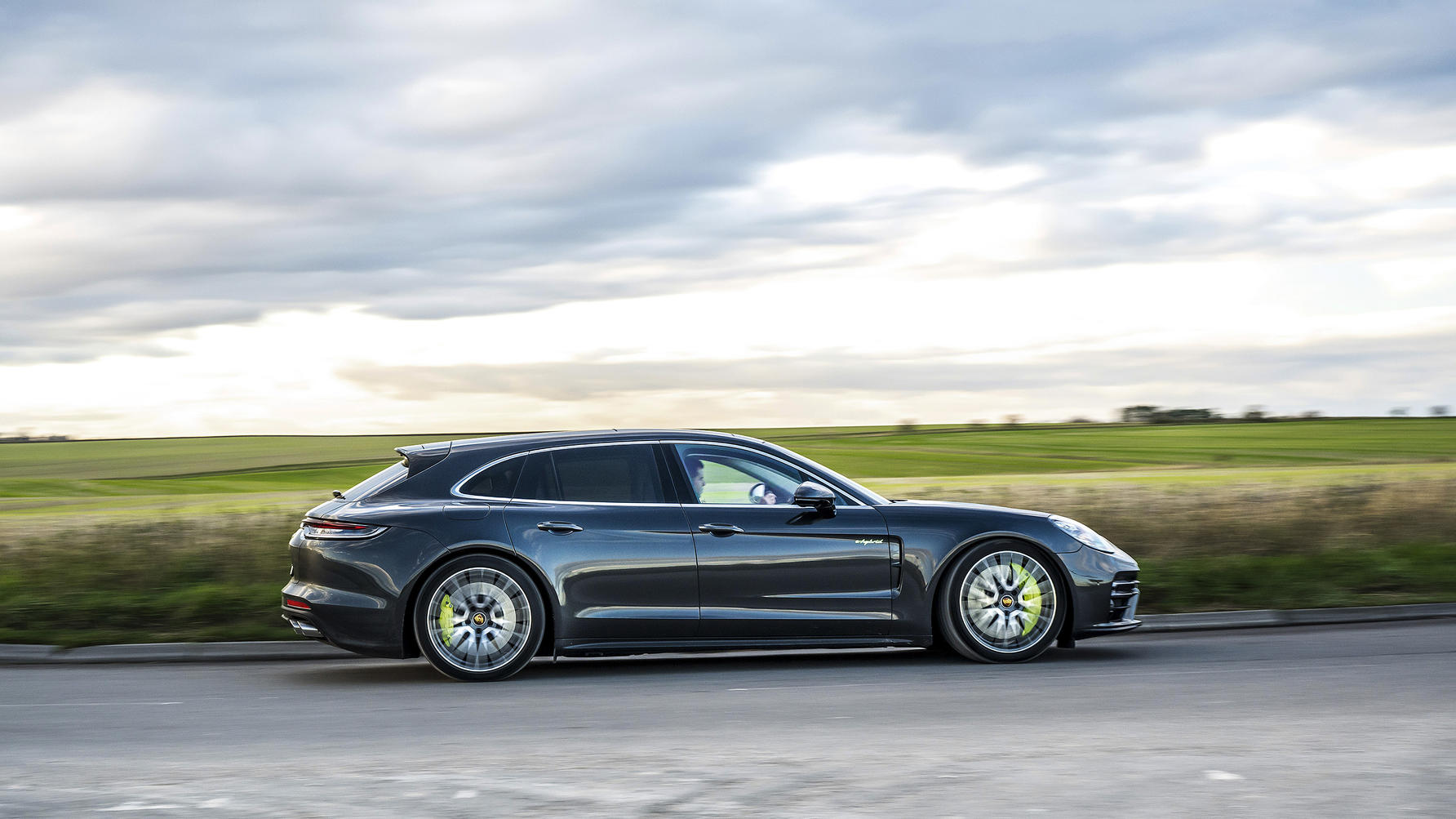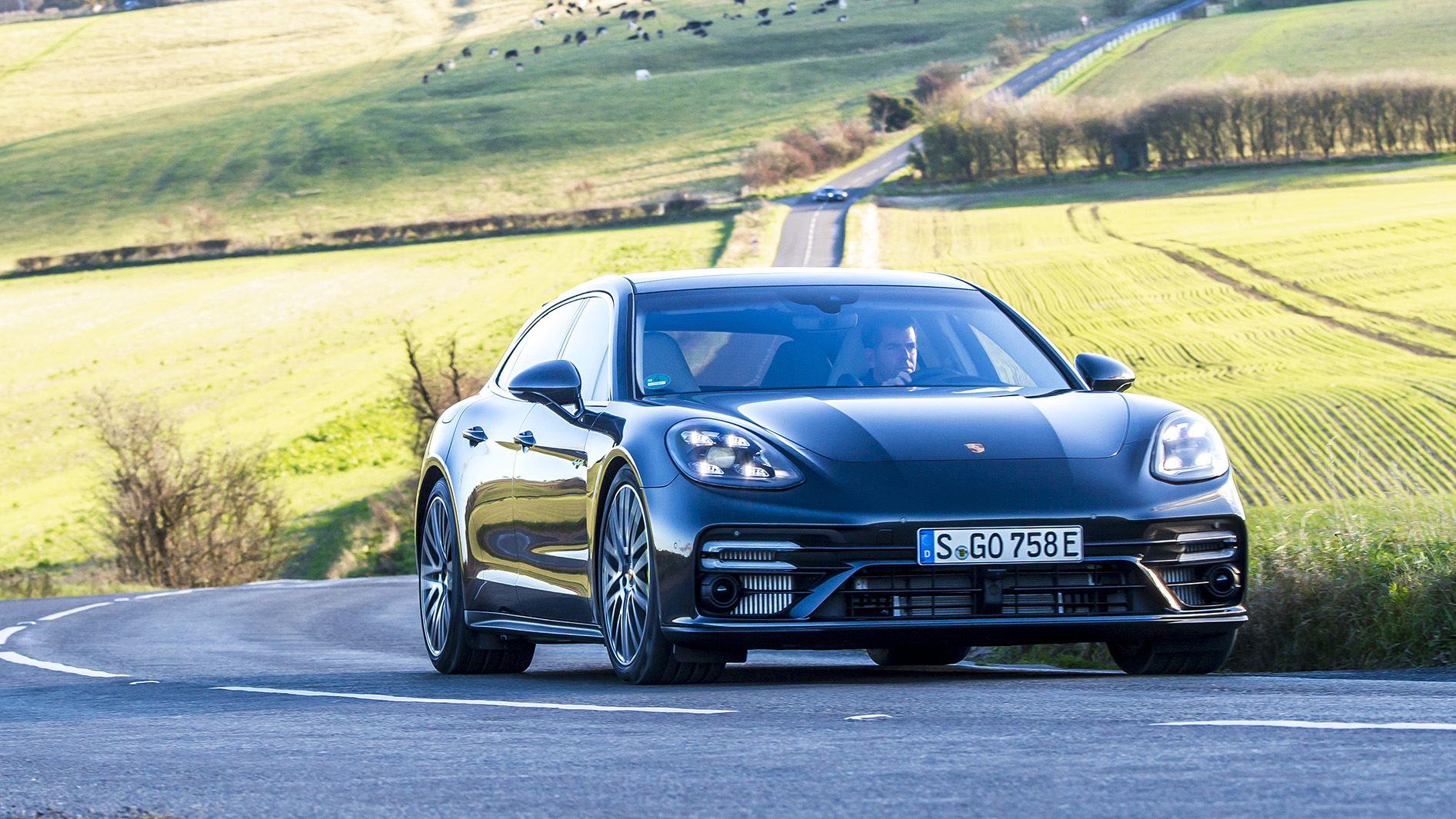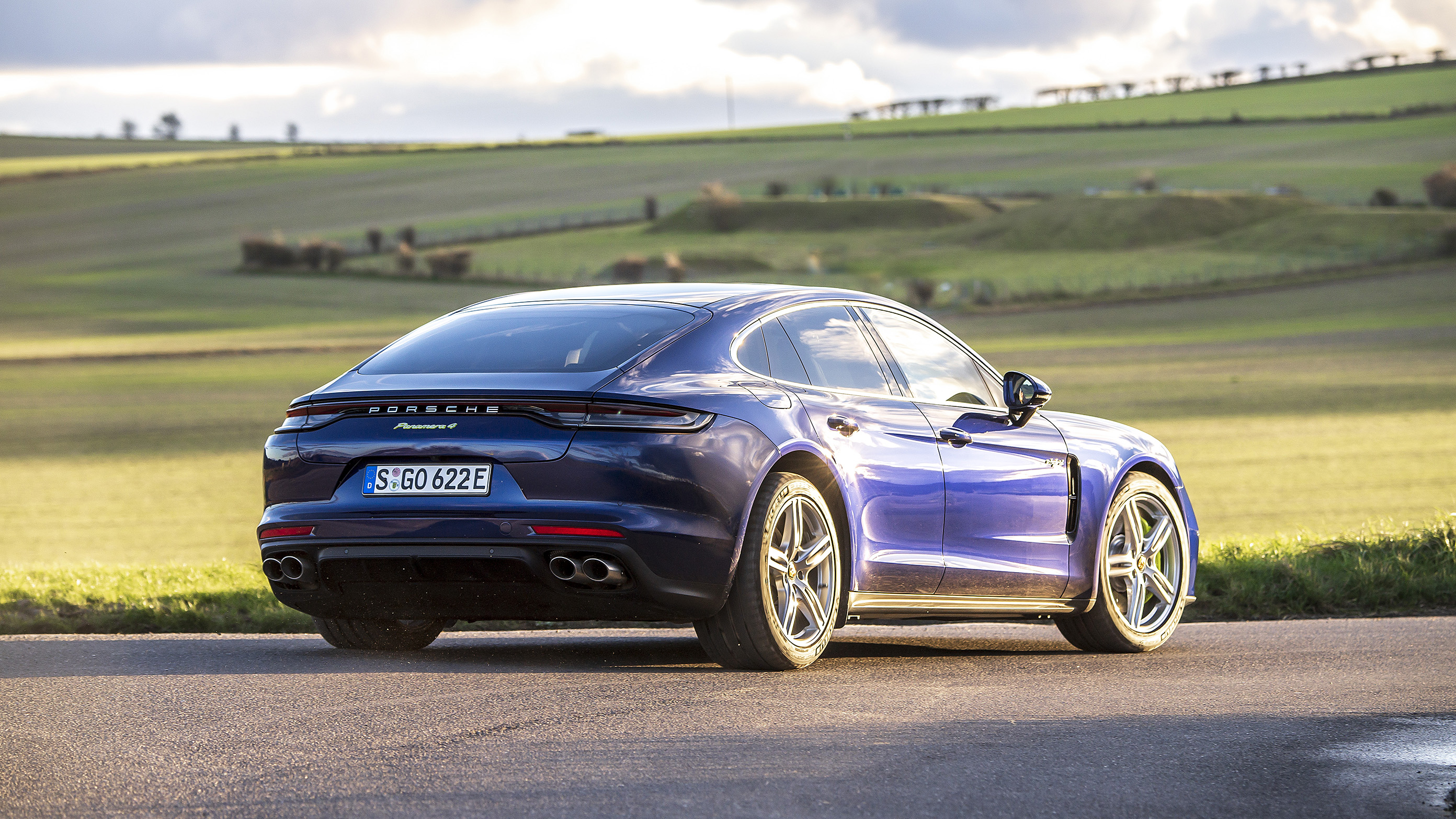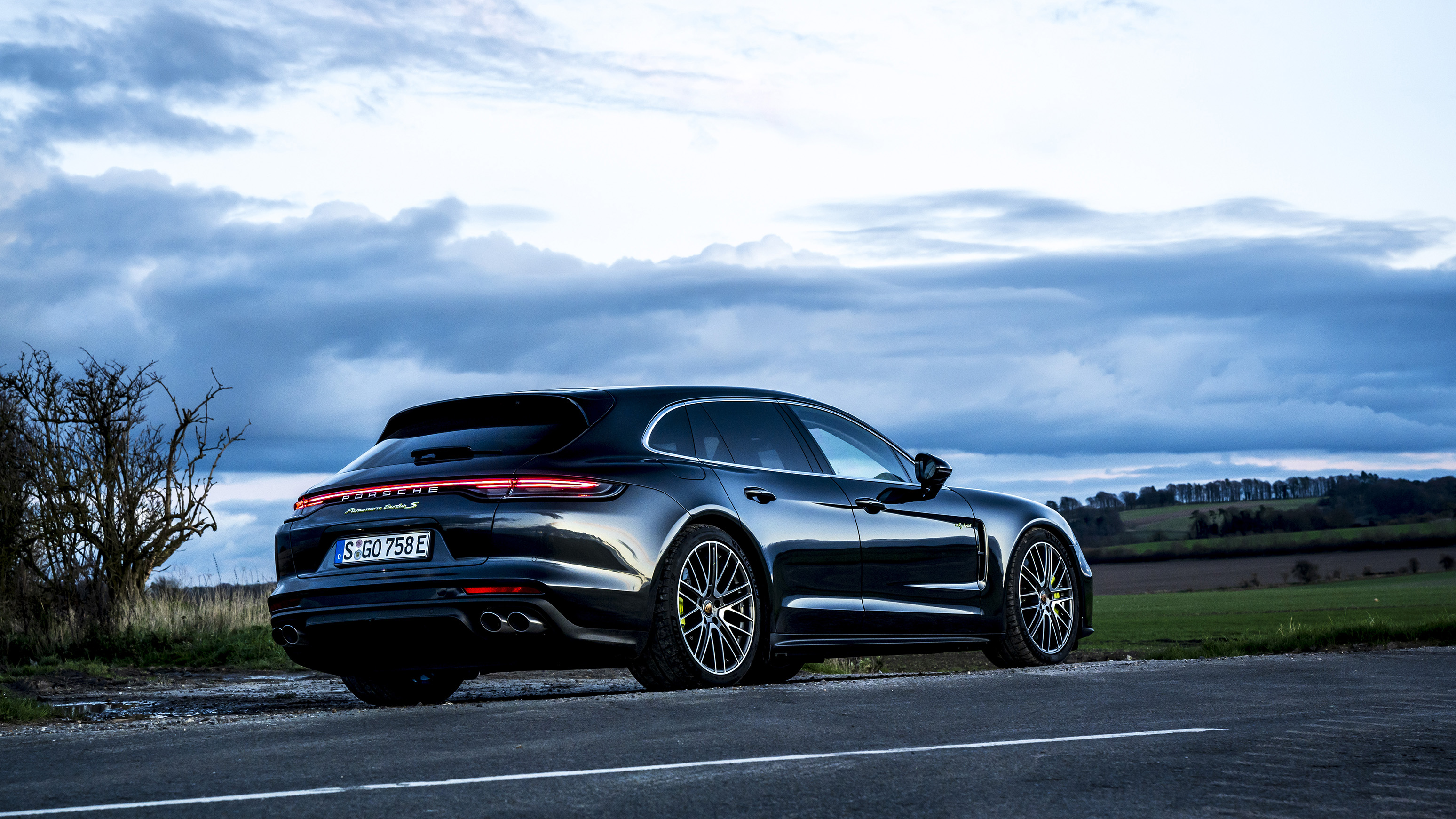
SPEC HIGHLIGHTS
- Battery
Capacity17.9kWh
- BHP
700bhp
- 0-62
3.2s
- Max Speed
196Mph
A Porsche facelift! The Emperor’s new headlights, then?
Isn’t cynicism about Stuttgart’s gently-does-it design getting a bit boring? Porsche doesn’t take an axe, a can of petrol and a box of matches to its styling studio every five years. If it did, it might well be churning out stuff like the gargoyles that wear BMW badges at the moment.
Instead, the facelifted Panamera has merely had a tweak. Redrawn bumpers. Engorged air intakes. It didn’t need them. It didn’t need more power either, but it’s got some…
You’re going to tell me that under the skin this is a whole new thing, powered by dark matter…
Not quite. Today we’re here to concentrate on the plug-in Panamera e-Hybrid family. That’s now grown to a trio: there’s the ‘base’ £84k Panamera 4 e-Hybrid, and at the other end of every scale you can think of, the mighty £140k Panamera Turbo S e-Hybrid.
In the middle, Porsche has slotted a new Panamera 4S e-Hybrid, splitting the difference on power (552bhp) and price (£101,000). Could be a belter.
With so many flavours of V6 / V8 / hybrid / non-hybrid / hatchback / estate on the menu, plus the Taycan, erm, taking four-door Porsches into a new realm of speed and futurism, does the world need so many different Panameras?
Why are you asking me? Ask Porsche.
I did. They say there’s no cause for cannibalism concern. But they would say that.
Porsche insists the Panamera and Taycan couldn’t be more different: one is a luxury long-distance GT that majors on lounging space and continental range, while the other is deliberately smaller and sportier, aimed at a totally different very-wealthy-person-desiring-a-rapid-quiet-and-comfortable-commute.
Top Gear
Newsletter
Thank you for subscribing to our newsletter. Look out for your regular round-up of news, reviews and offers in your inbox.
Get all the latest news, reviews and exclusives, direct to your inbox.
A Panamera driver will schlep longer distances. People travel in the back seats more of the time. In some countries EVs are now very desirable: very cutting edge. In others, you still need a gargling petrol engine to be taken seriously.
So there you have it. Everyone’s a lovey-duvvie happy family at Porsche, and there’s a four-door supercar for everyone. For how long, I wonder?
Getting back to what’s new with the Panamera, then…
Right you are. Chiefly, it’s the battery, which is more power dense than before. Before, there was a 14.1kWh battery – now it’s 17.9kWh, though due to improvements in battery chemistry it’s only 1.5kg heavier than the old cell pack.
Sounds great, until you learn the battery pack and associated gubbins heap 300kg onto the already portly Panamera. If you’re taking one of these on a car ferry, aim to park in the middle.
What does a bigger battery actually mean in The Real World?
30 per cent more e-range, apparently. Tricky to compare directly, as the older model was rated on a different test cycle, and we drove the new e-Panameras on a frigid December day, when the frostbitten ground was laced in freezing fog.
With an ambient temperature of a couple of Celcius, the fully charged Panameras offered 25-28 miles of e-range, which fell to 23-25 miles when the heater and bum warmers were cranked up. Hey, it was chilly okay?
What’s the difference between the bookends of Panamera hybrid life?
Power. In the Panamera 4 e-Hybrid, a 2.9-litre twin-turbo V6 provides the under-bonnet oomph: 456bhp of it, in total. It’s good for 0-62mph in 4.4 seconds and a top whack of 174mph. A fast car, objectively.
The Turbo S e-Hybrid cradles a 4.0-litre twin-turbo V8. On its own, it’s stronger than both power sources in the regular Panamera PHEV, delivering 564bhp – 20bhp more than the previous version. Add that to the gearbox-integrated electric motor and power’s mightily close to 700bhp. Torque. Oh yeah, there’s torque. How does 642lb ft grab you?
See, there are fast cars, and then there are Fast Cars. The Turbo S sees off 0-62 in just 3.2 seconds, races to 124mph in 11.2sec and tops out 196mph.

How much quicker is that than a Turbo S that’s not a hybrid?
Awkwardly, it’s not. The Panamera facelift heralded the arrival of a V8-powered, non-electrified Turbo S good for 621bhp, 0-62mph in 3.1sec, and 196mph. The e-Hybrid is so much heavier, its horsepower and torque advantages can’t overcome its £5k cheaper twin.
Porsche reckons the customers won’t care. One might need zero-CO2 range to dodge an urban emissions tax. Another will only care that their family gets to the country club faster than a pesky E63 or M5 Competition.
Are these two actually any good at being sporty Porsches?
Both are better than you might expect, one more so than the other. The Panamera 4 e-Hybrid has a go, but the V6 still sounds reedy even with the sports exhaust engaged, and the quantity of punch doesn’t seem to build with a linear squeeze of the throttle. You have to wait for the computers to agree before it surges forward.
What’s more, because it’s actually fairly economical – we saw 35mpg in the Hybrid Auto mode, which climbed past 40mpg with some electric only town-running – deploying Sport Plus mode and really clogging it feels weirdly… inappropriate. The display guilt-trips you as economy plummets into the twenties. Scroll through the modes and it huffs and rolls its eyes like a teenage daughter listening to dad-jokes. “Ugh, really..?”
This member of the Panamera family isn’t the one enthusiastic driver-folk will crave, but it swallows up a hefty proportion of Panamera sales, chipping in for the roll-cage-and-stickers unicorns. It’s more cohesive to drive than older Panamera plug-ins, but that hotter 4S might well be the sweet spot. Until then…
What about the Turbo S? Too heavy and confused to be a true four-door supercar, I presume?
So did I. But this car delights in changing – no – blowing your mind.
Porsche’s updates to the Panamera’s chassis and suspension have melded into an extraordinarily capable machine – a luxury barge (or in this case, estate) that can mix it with the best super-saloons from M and AMG yet soothe away the miles so quietly you can actually hear your passengers’ thoughts.
It's like a mighty Airbus A380 touching down without spilling the business-class champagne.
Body control is world-class, soaking up the worst rural roads of Oxfordshire (seriously, you couldn’t hold a WRC stage here; it’d be too bumpy) with an almost sneering disregard for surface changes. The world has a lot of 700bhp cars these days, but few make 700bhp as deployable – as downright exploitable – as the Porsche Panamera Turbo S e-Hybrid. Sport Turismo. That’s PPTSeHST for short.
Obviously, this is thanks to many acronyms. Porsche lobs the full thesaurus of handling alchemy at the flagship model: torque-vectoring diff, anti-roll suspension, rear-wheel steering, ceramic brakes and variable-ratio steering. In some cars – even in a 911 – this can add up to an aloof, clinically capable but difficult-to-read car. Here, it cogitates in harmony, and the result is a bit of kit that would demolish an Audi RS6 Avant, without the driver ever even pulling a paddleshifter.
This is a 2.3-tonne canal boat with the poise of a jet ski. The steering has such clarity and direct, trustworthy response it can be placed with delicacy, like a mighty Airbus A380 touching down without spilling the business-class champagne.
Sometimes you detect a hint of wriggle through the wheel as torque is poured forwards to maximise traction. It’s a mildly off-putting reminder of the sheer maths occurring every time you flex your big toe on the throttle pedal.
Oh, and when you really let it fly, the PPTSeHST does 16mpg. Whoops. The E-charge mode, which enlists the V8 to pumps the battery back up to 80 per cent, is more efficient this time around, but asking a big blown V8 to multitask while hurling a Range Rover’s worth of mass up-hill and down-dale chews through super-unleaded. Still, the tank’s a generous 80 litres. Meanwhile, the battery doesn’t eat into the Panam’s substantial boot.
So the Top Gear maths verdict is a £140k 700bhp hybrid is better than a £80k 455bhp hybrid? That’s helpful.
I prefer the Turbo S, because it’s better at doing what a Porsche should. It’s not just impressive from an engineer’s standpoint – it’s bloody exciting.
I love the sheer breadth of its abilities. It’s superb in town, polite in sleepy villages, svelte on the motorway, swift along A-roads and when the mood takes you, biblically fast. It’ll even have a good crack at being nimble. It now feels like a super-saloon with a climatology degree and a conscience, not a spoiled Panamera Turbo.
No-one on the planet needs this much from a car, but respect to Porsche for rolling up its sleeves and creating it nonetheless. Hybrid sales aren’t banned in the UK until 2035. Phew.
Porsche Panamera 4 e-Hybrid
7/10
2.9-litre twin-turbo V6 + e-motor
455bhp, 516lb ft
8spd DCT, AWD
0-62mph in 4.4sec, 174mph
112-141mpg (claimed WLTP), 45-57g/km CO2
2,220kg
£83,720
Porsche Panamera Turbo S e-Hybrid Sport Turismo
9/10
4.0-litre twin-turbo V8 + e-motor
691bhp, 641lb ft
8spd DCT, AWD
0-62mph in 3.2sec, 196mph
94-97mpg, 65-69g/km CO2
2365kg
£142,280
Featured

Trending this week
- Car Review
BMW 1 Series






